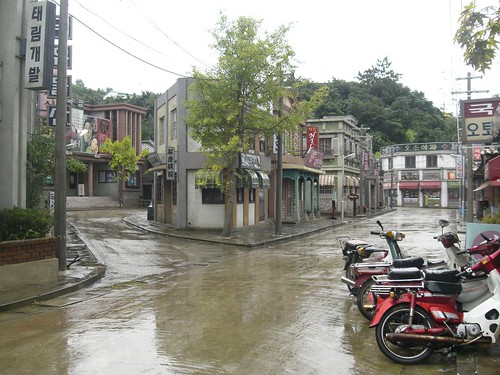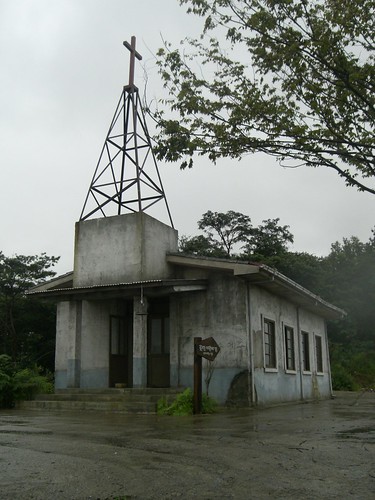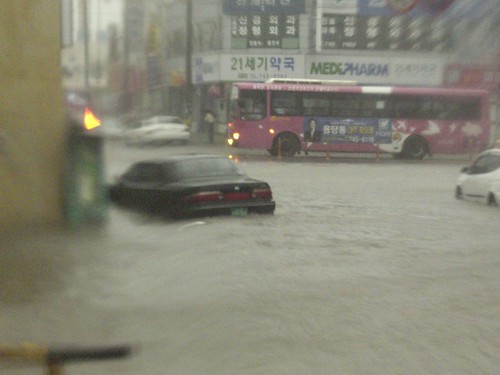A week ago I posted a question on Dave's ESL Cafe asking for information about Korean oldies and classic rock. I found a few links, so I thought I'd repost them here for anyone interested. This site has music from the 50s through the 00s, though it looks like most of it is from the 70s and 80s. There are, as of this post, 312 songs, and to browse you click the numbers at the bottom of the page. If you click directly on a link below, you can change songs by hitting "다음글" for next, or "이전글" for previous. Here are a few that I liked, and I'll be linking more as I find them (and please pardon my poor translations; I doubt their entirely accurate):
* 신중현과 엽전등, "바람," from 1975.
Shin Jung-hyeon and the Coins (?), "Wind."
*김선, "떠나야 할 그 사람," from 1969.
Kim Seon, "The One That's Leaving" (?)
*정훈희, "안게," from 1967.
Jeong Hun-hui, "Fog." This song was covered by current pop star BoA. See the video here.
*임희숙, "고향 하늘은 멀어도," from 1973.
Im Hui-suk, "Hometown sky is far away, too."
There are also a few good songs by the band He6 (히식스) on this naver blog. Numbers 3, 4, and 5 are good (you'll have to hit the "stop" button on the first one before you play the others.) The second #1 is a cover of "Proud Mary."
I'm going to spend some time digging around when I get the chance, and hopefully I find more good songs to post.
Saturday, September 22, 2007
Tuesday, September 18, 2007
Suncheon Drama Set
The day before Nari came I visited the Suncheon Drama Set, which, it turns out, is only a few blocks from my schools. It was used as a shooting location for some scenes of the SBS drama "Love and Ambition" (사랑과 야망). Despite the rain it was a pleasant trip, and I enjoyed walking through the park for an hour basically alone, as the weather kept folks away. Those interested in visiting should read the write-up on Galbijim and take a look at the SBS site (in Korean). There are a number of clips available on Youtube as well.
It's part of the Suncheon City Tour, but it seems a little off the beaten path. I hadn't heard of it until a week or so ago, when I saw a poster. Anyone interested in going can either do the city tour, or get on city bus 777, which will drop you off near the entrance. Anyway, the set is divided into 3 parts: 1960s Suncheon-eup, 1980s Seoul, and a generic 1970s slum, set on a hill in the back of the facility. One of the biggest differences between the Suncheon-eup set and the Seoul set was the amount of not only English, but English loan words written in Hangeul (Korean script). In Suncheon-eup, all of the signs were either written in Hanja (Chinese characters), or were Sino-Korean or Korean words.
I also want to add, before I post a few pictures, that "eup" translates to town, though in some cases it might be easier to think of it as "county seat." Suncheon eventually became an independent city, and grew in size when other towns were added to it. Before it became Suncheon-si (city), it was Suncheon-eup. Last year I lived in Gangjin-gun (county), Gangjin-eup, the largest town in the county and the county seat. On more than a few occassions, 1960s Suncheon-eup reminded me of 2007 Gangjin-eup.
"Central Theater" in Suncheon-eup.

A street in Suncheon-eup.

An intersection in Seoul.

A view of the "slum" (달동네).

A picture of a poster showing people on set in 1980s Seoul.

A church on top of the 달동네 hill. Fairly typical design of small country chapels.

I have 49 photos of the Drama Set on my flickr page, and the quality is a lot better.
It's part of the Suncheon City Tour, but it seems a little off the beaten path. I hadn't heard of it until a week or so ago, when I saw a poster. Anyone interested in going can either do the city tour, or get on city bus 777, which will drop you off near the entrance. Anyway, the set is divided into 3 parts: 1960s Suncheon-eup, 1980s Seoul, and a generic 1970s slum, set on a hill in the back of the facility. One of the biggest differences between the Suncheon-eup set and the Seoul set was the amount of not only English, but English loan words written in Hangeul (Korean script). In Suncheon-eup, all of the signs were either written in Hanja (Chinese characters), or were Sino-Korean or Korean words.
I also want to add, before I post a few pictures, that "eup" translates to town, though in some cases it might be easier to think of it as "county seat." Suncheon eventually became an independent city, and grew in size when other towns were added to it. Before it became Suncheon-si (city), it was Suncheon-eup. Last year I lived in Gangjin-gun (county), Gangjin-eup, the largest town in the county and the county seat. On more than a few occassions, 1960s Suncheon-eup reminded me of 2007 Gangjin-eup.
"Central Theater" in Suncheon-eup.

A street in Suncheon-eup.

An intersection in Seoul.

A view of the "slum" (달동네).

A picture of a poster showing people on set in 1980s Seoul.

A church on top of the 달동네 hill. Fairly typical design of small country chapels.

I have 49 photos of the Drama Set on my flickr page, and the quality is a lot better.
Monday, September 17, 2007
Typhoon Nari in Suncheon
I've posted these pictures elsewhere, but they're worth showing again. They're of Typhoon Nari (태풍나리) as it hit Suncheon, Jeollanam-do between 6 and 7 pm on Sunday, September 18. I was in Gwangju for the afternoon, and as the bus hit the outskirts---around Seo-myeon, north of downtown---the road had about a foot of water mixed with a lot of run-off from hills and fields. The more we got into town the deeper the water, and the blocks around the Intercity Bus Terminal had as much as a meter of water. I had to wade through the muck to get out of the terminal---no buses or taxis were going in or out, and the terminal was basically an island---and ended up walking some 6 kilometers back to my place. I was not happy.






This last photo is of Dongcheon, the river that runs through Suncheon. Normally there are walkingtrails along the river, but in this picture only the tops of the trees are visible, suggesting the water has risen at least 3 or 4 meters.

For comparison purposes, here's a photo taken in calmer weather from nearly the same spot. The walkers on the path add a bit of perspective:

There are another 20 or so visible on my flickr page.






This last photo is of Dongcheon, the river that runs through Suncheon. Normally there are walkingtrails along the river, but in this picture only the tops of the trees are visible, suggesting the water has risen at least 3 or 4 meters.

For comparison purposes, here's a photo taken in calmer weather from nearly the same spot. The walkers on the path add a bit of perspective:

There are another 20 or so visible on my flickr page.
Subscribe to:
Comments (Atom)